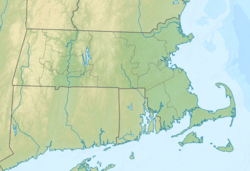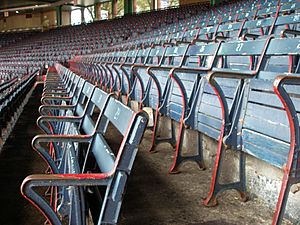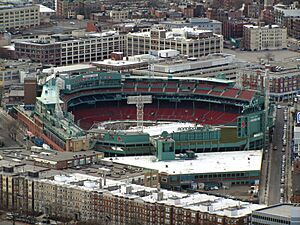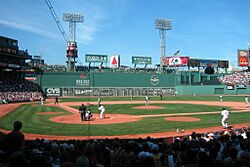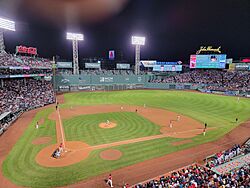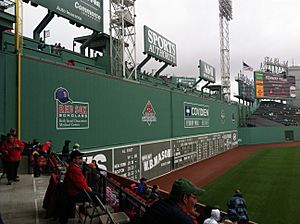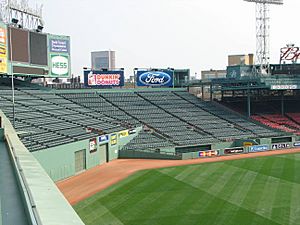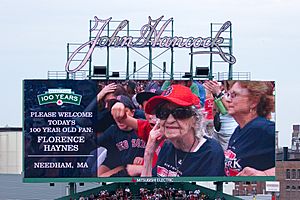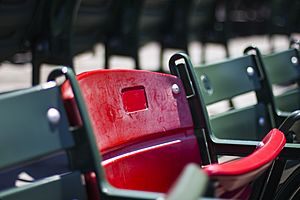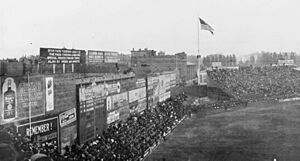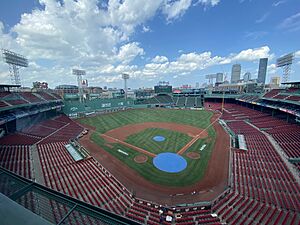Fenway Park facts for kids
|
America's Most Beloved Ballpark
Friendly Fenway |
|
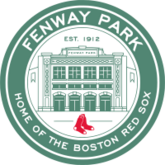 |
|
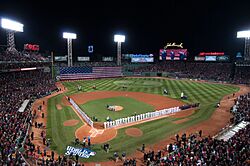
Fenway Park in 2013
|
|
| Address | 4 Jersey Street United States |
|---|---|
| Location | Boston, Massachusetts, U.S. |
| Coordinates | 42°20′47″N 71°5′52″W / 42.34639°N 71.09778°W |
| Public transit | at Lansdowne at Kenmore and Fenway |
| Owner | Fenway Sports Group |
| Operator | Fenway Sports Group / Boston Red Sox |
| Capacity | 37,305 (day) 37,755 (night) |
| Record attendance | 47,627 (September 22, 1935) |
| Field size | |
| Surface | Kentucky Blue Grass |
| Construction | |
| Broke ground | September 25, 1911 |
| Opened | April 20, 1912 |
| Renovated | 1988, 2002–2011, 2017 |
| Expanded | 1934, 1946, 2002–2011, 2017, 2022 |
| Construction cost | US$650,000 ($19.7 million in 2022 dollars ) |
| Architect | James E. McLaughlin |
| Structural engineer | Osborn Engineering Corp. |
| General contractor | Charles Logue Building Company, Coleman Brothers, Inc. |
| Tenants | |
|
|
|
Fenway Park
|
|
| NRHP reference No. | 12000069 |
| Added to NRHP | March 7, 2012 |
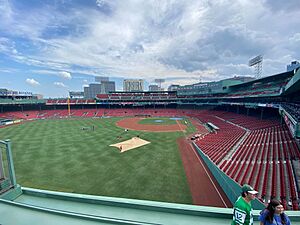
Fenway Park is a famous ballpark in Boston, Massachusetts. It's been the home field for the Boston Red Sox baseball team since 1912. This makes it the oldest active ballpark in Major League Baseball (MLB)!
Because it's so old and built in a busy part of Boston, Fenway Park has many unique features. These include "The Triangle," Pesky's Pole, and the famous Green Monster in left field. It's one of the smaller MLB ballparks, but it's full of history.
Fenway Park has hosted the World Series eleven times. The Red Sox won six of these, and the Boston Braves won one. Besides baseball, the park has also seen many other exciting events. These include professional football games, concerts, soccer matches, and even hockey games like the NHL Winter Classic.
In 2012, Fenway Park was added to the National Register of Historic Places. Many people see it as a symbol of Boston and a very special place for sports fans.
Contents
History of Fenway Park
How Fenway Park Got Its Name
In 1911, the Red Sox owner, John I. Taylor, bought land in Boston. He wanted to build a bigger baseball stadium. He named it Fenway Park because it was in the Fenway neighborhood. This area was created by filling in marshland, which are also called "fens." Taylor's family also owned a company called Fenway Realty, so the name helped promote their business too!
The park was designed by architect James E. McLaughlin. It was built on an uneven block of land. This is why the field has some unusual shapes and distances.
First Game and Other Events
The very first game at Fenway Park was on April 20, 1912. The Boston Red Sox beat the New York Highlanders 7–6. However, news about the game was overshadowed by the Titanic sinking that happened just five days earlier.
In 1919, a huge rally for Irish Independence took place at the park. Nearly 50,000 people came to see the President of the Irish Republic, Éamon de Valera. This was possibly the largest crowd ever at Fenway Park.
The park's address was originally 24 Jersey Street. For a while, it was called Yawkey Way, but in 2018, the street name went back to Jersey Street. The address is now 4 Jersey Street.
Changes Over the Years
Fenway Park has changed a lot since it first opened. Here are some of the major updates:
- In 1926, a fire destroyed the left field bleachers. They were rebuilt later.
- In 1933, Tom Yawkey bought the Red Sox and Fenway Park. He started a big reconstruction project.
- "Duffy's Cliff," a sloped area in left field, was removed. This made way for what we now call the Green Monster.
- New wooden bleachers were built.
- Concession stands, team offices, and the press box were updated.
- By 1934, the park looked much like it does today.
- The famous Green Monster wall was completed. It was 37 feet high, much taller than the old wall.
- A hand-operated scoreboard was added. It even had lights for balls and strikes, which was very modern then! People still update this scoreboard by hand today.
- The distances to the outfield walls were changed.
- In 1946, the first upper deck seats were added.
- In 1947, lights were installed for night games. The Red Sox were one of the last teams to get lights.
- In 2003, seats were added on top of the Green Monster.
- In 2004, more seats were added to the right field roof.
- From 2002 to 2011, Fenway Park underwent huge renovations. These changes helped keep the park usable for many more years.
New Fenway Park Plans
In 1999, there were plans to build a new Fenway Park next to the old one. The new park would have been bigger and more modern. However, many people wanted to save the historic Fenway Park. Groups like "Save Fenway Park" worked to stop the move.
Thanks to major renovations led by Janet Marie Smith, Fenway Park was saved. These updates made the park modern while keeping its classic feel. Experts now believe Fenway Park can be used until at least 2062!
Fenway Park Capacity and Sellout Streak
Fenway Park's seating capacity changes slightly between day and night games. During day games, some seats in center field are covered with a black tarp. This helps batters see the ball better.
The lowest number of fans ever at Fenway was just 306 people in 1964. But Fenway Park is also known for its amazing sellout streak!
On May 15, 2003, a game against the Texas Rangers sold out. This started a streak of sold-out games that lasted for many years. On September 8, 2008, Fenway Park broke the MLB record for consecutive sellouts with 456 games. The streak continued for a long time, reaching 794 regular season games and 26 postseason games. It finally ended on April 10, 2013.
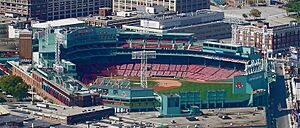
Unique Features of Fenway Park
Fenway Park is located in a busy area of Boston. It blends in with the surrounding buildings. When baseball player Roger Clemens first arrived in Boston, he thought his taxi driver had made a mistake. He said, "No, Fenway Park, it's a baseball stadium... this is a warehouse." He only realized he was in the right place when he saw the light towers!
Fenway Park is one of only two "jewel box" ballparks still used in MLB. These older parks often have seats with blocked views because of the pillars that hold up the upper deck. These seats are sold as such, reminding everyone of the park's old architecture.
Some people say Fenway Park is a "hitters' ballpark." This is because of its short right-field fence (302 feet) and narrow foul ground. These features can sometimes help batters get more hits.
The Green Monster Wall
The Green Monster is the famous nickname for the 37-foot-tall left field wall. It's about 310 to 315 feet from home plate. This short distance often helps right-handed batters hit home runs.
The wall was built in 1912 and was originally made of wood. In 1934, it was covered in tin and concrete, and the scoreboard was added. In 1976, it got a hard plastic covering. The scoreboard is still updated by hand during games. If a ball goes through a hole in the scoreboard, it's a special rule called a ground rule double.
The inside of the Green Monster is covered with signatures of players. Even though it's called the Green Monster, it wasn't painted green until 1947! Before that, it was covered with advertisements. In 2003, seats were added on top of the wall, giving fans a unique view.
"The Triangle" Outfield Area
"The Triangle" is a special area in center field where the outfield walls form a triangle shape. The farthest corner of this triangle is 420 feet from home plate. This deep right-center point is usually given as the center field distance.
The Lone Red Seat
In the right field bleachers, there's one red seat (Section 42, Row 37, Seat 21). This seat marks the longest home run ever hit at Fenway Park! Ted Williams hit this amazing home run on June 9, 1946. It was measured at 502 feet.
The ball hit a man named Joseph A. Boucher on the head! He later joked, "How far away must one sit to be safe in this park?"
Pesky's Pole and Fisk Foul Pole
Pesky's Pole is the name for the foul pole on the right field line. It's only 302 feet from home plate, making it the shortest outfield distance in MLB. It's named after Johnny Pesky, a Red Sox player and coach. He hit some of his home runs near this pole. The Red Sox officially dedicated it as "Pesky's Pole" on his 87th birthday in 2006.
On the left field foul line, atop the Green Monster, is the Fisk Foul Pole, also called Pudge's Pole. It's named after Carlton Fisk. In Game 6 of the 1975 World Series, Fisk hit a long fly ball that looked like it was going foul. He famously waved his arms to try and keep it fair. The ball hit the foul pole, winning the game for the Red Sox!
Duffy's Cliff
From 1912 to 1933, there was a 10-foot-high slope in front of the left field wall. This area was called "Duffy's Cliff," named after star left fielder Duffy Lewis. Outfielders had to run uphill to catch balls! The slope was removed in 1934 during renovations.
Dell EMC Club
In 1983, private suites were added behind home plate. In 1988, a glass-enclosed seating area called the "600 Club" was built. It was later renamed the ".406 Club" to honor Ted Williams' amazing .406 batting average in 1941. After more renovations, it became the "Dell EMC Club" and the State Street Pavilion, offering premium seating and services.
Statues at Fenway
Outside Gate 5, you can find The Teammates statue. It shows Red Sox legends Bobby Doerr, Dom DiMaggio, Ted Williams, and Johnny Pesky together. There's also a separate statue of Ted Williams putting his cap on a young boy's head.
Events at Fenway Park
Baseball Games
Fenway Park is mostly known for baseball. The Boston Braves also played some games here in 1914 and 1915.
Since 1990, Fenway has hosted the final round of the Baseball Beanpot. This is a college baseball tournament for teams from the Boston area.
Since 2002, the song "Sweet Caroline" by Neil Diamond has been played during the middle of the eighth inning at Red Sox games. It's become a beloved tradition!
The Red Sox also host "Futures at Fenway" events. This is where their minor-league teams play games at the big stadium.
Baseball Records and Moments
- The first home run at Fenway Park was hit by Hugh Bradley on April 26, 1912.
- Rube Foster pitched the first no-hitter at Fenway in 1916.
- In 1959, Elijah "Pumpsie" Green became the first African-American player for the Red Sox to play at Fenway.
- Reggie Smith was the first player to hit a home run from both sides of the plate at Fenway in 1967.
Other Sports and Entertainment
Fenway Park has hosted many other exciting events:
- Boxing: The park has held boxing matches since 1920. Famous boxers like James J. Braddock and Tony DeMarco have fought here.
- Soccer: Soccer games have been played at Fenway since 1925. European clubs like Celtic F.C. and Liverpool have played exhibition matches here.
- American Football: Football has been played at Fenway since it opened in 1912. Teams like the Boston Redskins and Boston Patriots used to call it home. College teams like Boston College and Notre Dame have also played games here. The Fenway Bowl, a college football bowl game, started being played here in 2022.
- Professional Wrestling: Wrestling events have also taken place at Fenway, drawing large crowds in the past.
- Hockey: Fenway Park has hosted ice hockey games multiple times. The NHL Winter Classic was played here in 2010 and 2023, with the Boston Bruins winning both times! The "Frozen Fenway" series also features college and high school hockey games.
- Hurling and Gaelic Football: These traditional Irish sports have been played at Fenway, including the Fenway Hurling Classic.
- Concerts: Many famous musicians have performed at Fenway Park. Stevie Wonder and Ray Charles played here in 1973. Since 2003, artists like Bruce Springsteen, Paul McCartney, Lady Gaga, and Aerosmith have rocked the stadium. Lady Gaga was the first woman to headline a concert at Fenway in 2017.
- Ski and Snowboard: In 2016, Fenway Park hosted the "Polartec Big Air At Fenway." This was a snowboarding and skiing competition with a huge 140-foot-tall jump built in the stadium!
Public Address Announcers
The public address (PA) announcer is the voice of Fenway Park. Many people have held this job over the years. Sherm Feller was the announcer for 26 years, known for his welcoming phrase: "Good afternoon, ladies and gentlemen, boys and girls. Welcome to Fenway Park." Carl Beane was another beloved announcer who served from 2003 until his passing in 2012.
Retired Numbers
Above the right field grandstand, you can see the retired numbers of Red Sox legends. These numbers are red on a white circle. Jackie Robinson's number 42, retired by all of Major League Baseball, is blue on a white circle.
The Red Sox have special rules for retiring numbers. Usually, the player must be in the Hall of Fame, play at least 10 years with the team, and retire as a Red Sox player. However, exceptions have been made for players like Johnny Pesky and Carlton Fisk because of their long and important service to the team. The most recent number retired was 34, worn by David Ortiz.
| Red Sox retired numbers | |||||
| No. | Player | Position | Red Sox Years | Date Retired | Notes |
|---|---|---|---|---|---|
| 1 | Bobby Doerr | 2B | 1937–44 1946–51 |
May 21, 1988 | US Army, 1945 |
| 4 | Joe Cronin | SS | 1935–45 | May 29, 1984 | Player-Manager |
| 6 | Johnny Pesky | SS, 3B, 2B | 1942, 46–52 | September 28, 2008 | US Navy, 1943–45 |
| 8 | Carl Yastrzemski | LF, 1B, DH | 1961–83 | August 6, 1989 | AL MVP (1967) Triple Crown (1967) |
| 9 | Ted Williams | LF | 1939–42 1946–60 |
May 29, 1984 | US Marines, 1943–45, 52–53 |
| 14 | Jim Rice | LF, DH | 1974–89 | July 28, 2009 | AL MVP (1978) |
| 26 | Wade Boggs | 3B | 1983–1992 | May 26, 2016 | |
| 27 | Carlton Fisk | C | 1969, 71–80 | September 4, 2000 | AL Rookie of the Year (1972) |
| 34 | David Ortiz | DH | 2003–2016 | June 23, 2017 | 3× World Series Champion (2004, 2007, 2013) 2004 ALCS MVP 2013 World Series MVP |
| 45 | Pedro Martínez | P | 1998–2004 | July 28, 2015 | World Series Champion (2004) |
| 42 | Jackie Robinson | Brooklyn Dodgers 1947–1956, retired by Major League Baseball, April 15, 1997 | |||
Ground Rules for Baseball
Fenway Park has some special ground rules because of its unique design:
- If a ball goes through the scoreboard, it's a ground rule double.
- A fly ball that hits the left-center field wall to the right of the flagpole is a home run.
- If a fly ball hits a wall or flagpole and bounces into the bleachers, it's a home run.
- A fly ball that lands above the red line on top of the Green Monster and bounces back onto the field is a home run.
- If a ball gets stuck in the bullpen screen or bounces into the bullpen, it's a ground rule double.
Getting to Fenway Park
Fenway Park is easy to reach using Boston's public transportation system, the Massachusetts Bay Transportation Authority (MBTA).
- You can take the Green Line subway to Kenmore station or Fenway station.
- The Lansdowne station is served by commuter rail trains. This line connects to South Station and Back Bay.
- You can also take the Orange Line or commuter rail to Back Bay or Ruggles stations. From there, it's about a 30-minute walk to Fenway.
- If you're driving, you can use Storrow Drive to get to the park.
See also
 In Spanish: Fenway Park para niños
In Spanish: Fenway Park para niños



